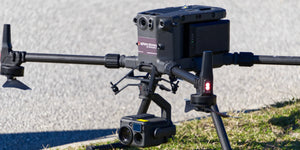Powerline inspections are a time-consuming task requiring a dedicated team to go out and visually inspect each power pole and the line running between them. Landborne robots can remove the human element and allow them to be put to work in more thought intensive roles while increasing efficiency and lowering inspection costs.
How ground-based powerline inspection works
- A landborne robot, like Spot from Boston Dynamics is pre-programmed with an AI-based system to detect power poles and the powerlines.
- Once that's taken care of Spot is sent out and autonomously walks under the powerline. As it reaches a power pole it stops, rotates the camera up and captures the required data.
- The data is streamed back to a control centre to look over as well as recorded on Spot for a secondary inspection.
- Spot automatically finds its charging and data dock to recharge and share its data, before repeating it all again the next day.
Benefits of using landborne robots
- Landborne robots such as Spot can work around the clock with short breaks to recharge improving efficiency and covering more ground.
- Human workers can be used in more critical thinking tasks that they are much better suited to.
- Safety is dramatically increased with the human factor being completely removed from the equation.
- Data captured is higher quality and can be easily inspected for a second opinion.
Image via SA Power



















